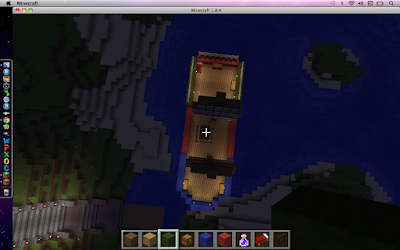For this final assignment we were asked to build a too scale model of the boston tea party ship in minecraft. Since my boat was on the water I had to make a base to hold the ship up. I tried to make it as real looking as possible and had a hard time doing the inside part because there was no real pictures. I used my imagination.
This was the base 30 blocks long and 7 blocks wide.
I initially had yellow as the base but then i changed it to black.
I used yellow black, blue, green, and red.
Birch wood floors.
Made 2 sails 20 blocks high.
I made a library in the basement.
Entrance to the stairs.
The final product I hope you liked it!
This is the image I based my ship off of.
This is a final project using Minecraft to build a replica of the Eleanor ship from the Boston Tea Party. It is a final exercise from the Immersive Education course that I am taking at Boston College. The course is called Discovering Computer Graphics. For details, visit the immersive BC portal at http://ImmersiveEducation.org/@/bc


















